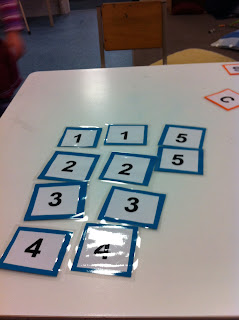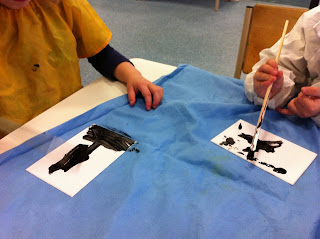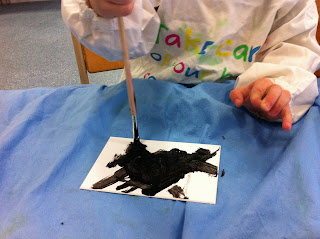Unfortunately I will be taking a hiatus from blogging until I get the internet connected up in my new house. I will try and write blogs at home and then hopefully post them from work.
Hopefully.
Until then,
BYEEEEE :)
Wednesday, July 20, 2011
Thursday, July 7, 2011
Indoor Gross Motor - Hopscotch
Hopscotch saved me from going insane today.
How do you wear out 3 year olds just before bed when its to wet/cold/windy to go outside?
Hopscotch.
They were so determined to hop. some could manage the hop-jump-hop-jump-hop-jump-turn around combination, while others couldnt quite co ordinate it and just managed one hop while some just jumped.
10 stars for effort.
We will definitely be adding this to the program!
Wednesday, July 6, 2011
Matching Cards
Today my room leader introduced a set of 'matching cards' to the program.
Alot of the children are starting to show an interest in developing their writing and reading skills.
We thought this was a good way for the visual learners to become familiar with letters and numbers.
We made a set of letters too, and the plan is that we will only put out the first letter from each child's name. This way, the letters have purpose and meaning and familiarity.
It is also a good activity for children who arent quite at the stage where they want to learn to write their name/read their own books because they can match the letters by site.
These cards are so open ended. Here are some ideas of how you could use them
- Ask children to find you a set of matching numbers
- Hold up a card and ask children to find the one that matches
- Get children to line them all up in order (backwards or forwards)
- Ask children to group together the even and odd numbers (for the older ones)
- Encourage the children to make bigger numbers and tell you what they are (for the older ones)
- Ask children to find their age in number. And then ask them to find the number they will turn next year.
- Get children to group together numbers with similiar features. i.e, numbers with holes 6 8 0, numbers with no straight lines 6 8 3 etc etc
- Point to a number and ask children to name it
- Turn them all upside down and the children can use their memory to pick up two matching ones
Tuesday, July 5, 2011
Using up the black paint.
Every room in every childcare centre/kinder/family daycare has that one bottle of black paint that is still nearly full to the top. It could be hiding at the back of the cupboard. It might be on the top shelf you can't reach. It may be in the store room tucked up the back. Yesterday, I took one brave step for early childhood educators and unleashed the black paint from the cupboard.
Tips for using black paint
Tips for using black paint
- Isolate it. Use JUST black, or let the children add black after the other colours of paint have dried. Or before the fact. This prevents the black blending with other colours and turning out a mushy browny colour (unless of course, this is your aim)
- Use it liberally. If you're going to unleash the power of black paint, do it in full force. This is especially important if you dont often allow children to use black paint
- USE SMOCKS, think of the parents complaints if their childs green jumper goes home black.
We did a few paintings on small card
And then we started to paint the whole peices of card in thick black paint
Inside I was thinking NOOOO, YOURE WASTING MY CARDBOARD AND BLACK PAINT! DONT PAINT THEM ALL BLACK, YOUR PARENTS WILL FROWN AT ME WHEN I SHOW THEM!
But luckily, my inner ECE thought, its about the process not the product.
But the children suprised me.
Apparently, I was worrying for nothing.
Duh, Justine. theyre night skies.
What a silly grown-up I am.
I suggested we should add some stars to our night sky
So we added some glitter for the stars.
And Voila! Night skies.
I hole punched them all in the top and threaded fishing line through and plan to hang them tomorrow.
Friday, July 1, 2011
Squishy Squashy Goo
GOO, GLORIOUS GOO!
A few days ago, I made up a whole heap of cel-mix and made it quite runny.
I placed it in all sort of jars and pots and bowls and also in some squeezy bottles
I added some green food dye and blue glitter to half, and left the other half plain so the children could see how the green goo made the plain goo go green too (try saying that ten times really fast!)
I placed some table covers over the tables ( a VERY VERY VERRYYY sensible thing to do) so when we were done I could just bundle up the table cover and put it straight to the laundry basket.
And we pretty much just let the children go loose. I grabbed some little bowls and pots from the home corner, and some wooden spoons and other utensils from the playdough tool box and added them to the table, which provided the children who didnt want to touch the goo with their hands the opportunity to participate too.
We did this as our 'group time' activity to give the children a chance to try something new in a group environment
The only sound in the whole room was the squelching of glue and the occasional laugh.
The children were pretty in awe of this goo. I dont think they realised it was the same stuff they hate getting on their hands when we do pasting (we often use cel-mix as glue) Its amazing the difference green food dye makes!
The children mostly used the goo on their own, I think this was because they have never had the opportunity to take part in an experience like this, and because it was the first time we had done it.
This was definitely a hit with the children, and it is such a wonderful sensory experience.
Even as an adult, I find it so satisfying to stick my hands in a bucket of goo and give it a squish. It feels satisfying!
The good thing about this goo is that it will be good for 2-3 days before it starts to go lumpy in which case you can always add water, as long as the goo hasnt gotten to dirty. I only plan to keep it until tomorrow afternoon because I dont want the children passing around colds by wiping their nose on the back of the hand and then putting it into the goo, but if you were doing it at home, you could use it for 4-5 days as long as you kept on adding a bit of water when it starts to get lumpy!
Labels:
creativity,
group activity,
messy,
science,
sensory
Thursday, June 30, 2011
Fundraising: Cadbury Chocolates
Currently at my centre we are doing some fundraising so that we can create an early childhood education library for parents to borrow books from, so that parents have the chance to increase and expand their knowledge about children's development and the way children learn.
We are doing this by fundraising through Cadbury. We get 40 cents from every chocolate bar sold, and each chocolate bar is $1. They come in boxes of 50, so for every 50 bars sold, we get $20 direct profit.
Its one of the most successful fundraisers we have done in the past, and one that the parents normally dont mind helping out with it because the chocolate bars sell themselves.
We are doing this by fundraising through Cadbury. We get 40 cents from every chocolate bar sold, and each chocolate bar is $1. They come in boxes of 50, so for every 50 bars sold, we get $20 direct profit.
Its one of the most successful fundraisers we have done in the past, and one that the parents normally dont mind helping out with it because the chocolate bars sell themselves.
Wednesday, June 29, 2011
Toddlers: Daily Care
I was just browsing the Raising Children website, and found this article about toddler daily care. It has a good video at the bottom of the page about toilet training that has Australian mums talking about toilet training.
Definitely a good page to look at for early childhood educators just to ground us and remind us of what realistic expectations are when it comes to toddlers. It's very easy when you are surrounded by children at all different stages and all different ages, to get caught up in comparing children to other children. Well at least that what happens to me.
The Raising Children website is an Australian website funded and put together by Department of Housing, Families, Community Services and Indigenous Afffairs. I discovered it when studying last year. Its useful not just for children but ECE's too.
Definitely a good page to look at for early childhood educators just to ground us and remind us of what realistic expectations are when it comes to toddlers. It's very easy when you are surrounded by children at all different stages and all different ages, to get caught up in comparing children to other children. Well at least that what happens to me.
The Raising Children website is an Australian website funded and put together by Department of Housing, Families, Community Services and Indigenous Afffairs. I discovered it when studying last year. Its useful not just for children but ECE's too.
Subscribe to:
Comments (Atom)

















